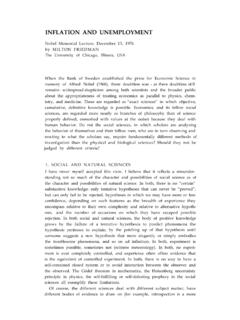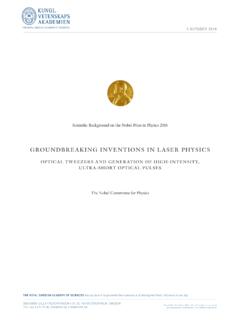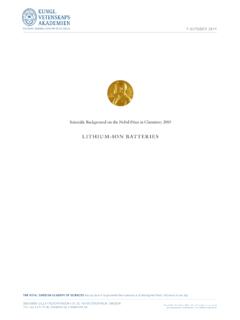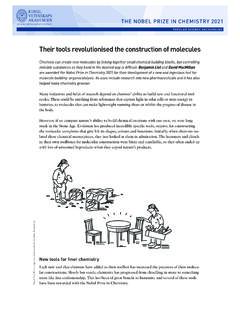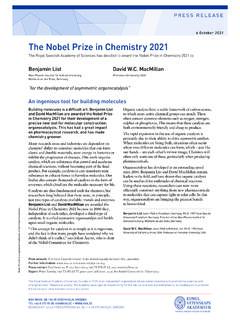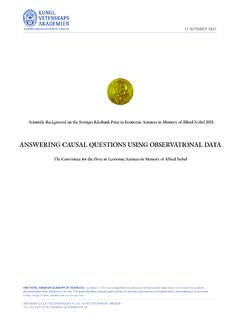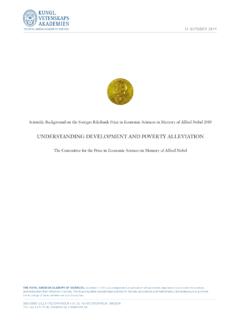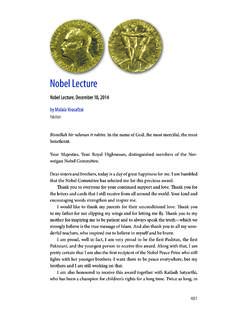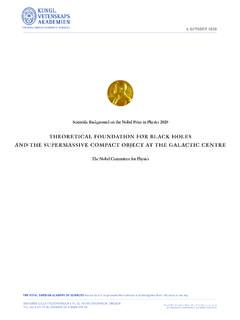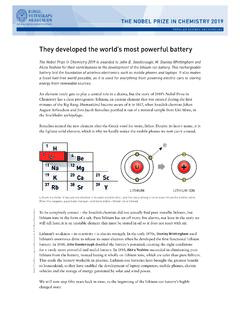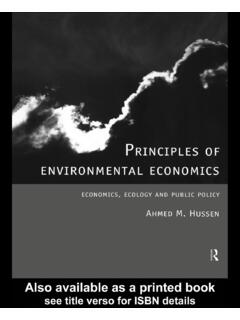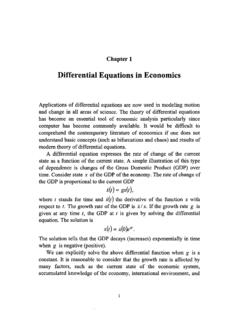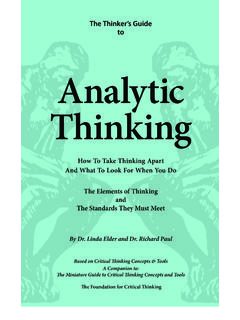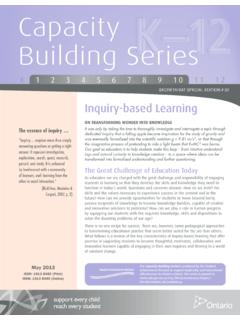Transcription of Climate change: The Ultimate Challenge for Economics*
1 439. Climate change : The Ultimate Challenge for Economics*. Prize Lecture, December 8, 2018 by William D. Nordhaus Yale University, USA. the science of economics covers a vast terrain, as is clear from the history of Nobel awards in this area. Among the many fields that have been recognized are portfolio theory to reduce investment risk, the dis- covery of linear programming algorithms to solve complex allocation problems, econometric methods as a way of systematically understanding history and behavior, economic growth theory, and general-equilibrium theory as the modern interpretation of the invisible hand of Adam Smith. The award this year concerns another of the many fields of economics. It involves the spillovers or externalities of economic growth, focusing on the economics of technological change and the modeling of cli- mate- change economics. These topics might at first view seem to live in separate universes. The truth is that they are manifestations of the same fundamental phenomenon, which is a global externality or global public good.
2 Both involve science and technology, and both involve the inability of private markets to provide an efficient allocation of resources. They *The research underlying this essay has benefitted from the contributions of innumerable teachers, collaborators, students, and institutions, many of whom are mentioned below. Be- cause they are so numerous and their contributions are so deep, I will mention only one, who was a guiding mentor and contributor for many decades, Tjalling Koopmans. He represents the spirit of courageous innovation in many fields of economics and can stand in for the many others whose work fills the equations and pages of Climate - change economics. 440 THE NOBEL PRIZES. also draw on the fields mentioned above as integral parts of the theoreti- cal apparatus needed to integrate economics, risk, technology, and cli- mate change . The two topics not only share a common intellectual heritage, but also are both of fundamental importance.
3 Technological change raised humans out of Stone Age living standards. Climate change threatens, in the most extreme scenarios, to return us economically whence we came. Humans clearly have succeeded in harnessing new technologies. But humans are clearly failing, so far, to address Climate change . My colleague Paul Romer has made fundamental contributions to understanding the global externality of knowledge, and we learn of that key discovery in his essay. This essay addresses the Climate - change exter- nality its sources, its potential impacts, and the policy tools that are available to stem the rising tides and damages that this externality will likely bring to humans and the natural world. It draws upon my writings in the area, most of which is cited in the references. Climate change AS A GLOBAL PUBLIC GOOD. I begin with the fundamental problem posed by Climate change that it is a public good or externality. Such activities are ones whose costs or bene- fits spill outside the market and are not captured in market prices.
4 These include positive spillovers like new knowledge and negative spillovers like pollution. The two key attributes of a public good are, first, that the cost of extending the output to an additional person is zero ( nonrivalry ) and, second, that it is impossible to exclude individuals from enjoying it ( non- excludability ). The theory of public goods was developed by Paul Samu- elson (1954), the first American Nobel laureate in economics, and it is fundamental to environmental economics today. Paul Romer applied these concepts to knowledge and invention in his path-breaking research. The theory of public goods applies as well to Climate change . Here, we are speaking of a negative externality or public bad in the form of greenhouse gas (GHG) emissions rather than a public good of improved knowledge. Climate change is a particularly thorny externality because it is global. Global externalities, whose impacts are indivisibly spread around the entire world, are not new.
5 In earlier centuries, countries faced religious conflicts, marauding armies, and the spread of infectious dis- eases such as the plague. In the modern world, the older global challenges have not disappeared, while new ones have arisen including not only global warming but others such as the threat of nuclear proliferation, international financial crises, and the growing threat of cyberwarfare. Global externalities are different from local or national public goods William D. Nordhaus Lecture 441. Figure 1. Climate change as the Threatening Colossus [Francisco de Goya, El Coloso, Copyright Museo Nacional del Prado]. because they resist the control of both markets and national govern- ments, a point emphasized below. Global warming is the most significant of all environmental externali- ties. It menaces our planet and looms over our future like a Colossus (see Figure 1 from Goya). It is particularly pernicious because it involves so many activities of daily life, affects the entire planet, does so for decades and even centuries, and, most of all, because none of us acting individu- ally can do anything to slow the changes.
6 Further reflection will reveal that nations have had limited success with agreements to deal with global economic externalities. Two success- ful cases include handling international trade disputes (today primarily through the World Trade Organization) and the protocols to limit the use of ozone-killing chlorofluorocarbons (from the Montreal Protocol). The study of economic aspects of environmental treaties has been pioneered by Columbia University economist Scott Barrett (1994, 2003). He and other scholars believe these two treaties were successful because the ben- efits far outweighed the costs and because effective institutions were cre- ated to foster cooperation among nations. Governance is a central issue in dealing with global externalities because effective management requires the concerted action of major countries. However, under current international law, there is no legal mechanism by which disinterested majorities of countries can require other nations to share in the responsibility for managing global externali- ties.
7 Moreover, extralegal methods such as armed force are hardly recom- mended when the point is to persuade countries to behave cooperatively rather than free-riding. 442 THE NOBEL PRIZES. It must be emphasized that global environmental concerns raise com- pletely different governance issues from national environmental concerns. For national public goods, the problems largely involve making the national political institutions responsive to the diffuse national public interest rather than concentrated national private interests responsive to public health rather than private profits. For global public goods, the problems arise because individual nations enjoy only a small fraction of the benefits of their actions. In other words, even the most democratic of nations acting non-cooperatively in its own interest would take minimal action because most of the benefits of cooperation spill out to other nations. It is only by designing, implementing, and enforcing cooperative multinational policies that nations can ensure effective Climate - change policies.
8 INTEGRATED-ASSESSMENT MODELING. Many areas of the natural and social sciences involve complex systems that link together multiple physical or intellectual sectors. This is par- ticularly true for environmental problems, which have deep roots in the natural sciences but also require social and policy sciences to solve in an effective and efficient manner. A good example, which will be the subject of this essay, is Climate - change science and policy, which involve a wide variety of disciplines such as atmospheric chemistry and Climate science, ecology , economics, political science, game theory, and interna- tional law. As understanding progresses across the different fronts, it is increas- ingly necessary to link disciplines together to develop effective under- standing and efficient policies. Integrated assessment analysis and models play a key role here. Integrated assessment models (IAMs) can be defined as approaches that integrate knowledge from two or more domains into a single framework.
9 These are often based on fundamental scientific theo- ries, but in practice are increasingly computerized numerical dynamic models of varying levels of complexity (for a survey, see Nordhaus 2013.). My own work on IAMs for Climate change began with a simple energy/ Climate model in Nordhaus (1975, 1977). I discarded this for other approaches, such as an analytical model, a small macroeconomic model (Nordhaus and Yohe 1983), a static model with a damage function (Nordhaus 1990), and finally in Nordhaus (1992, 1994) hit upon a model that captured all the parts in the DICE model (Dynamic Integrated model of Climate and the Economy). The latest full version of the DICE. model (DICE2016-R2) has much the same structure as the first version, but it has revised each of the major sectors in small or large ways. The evolution of the DICE model 1992 2016 is reviewed in Nordhaus 2018a. William D. Nordhaus Lecture 443. Additionally, the DICE model has spawned several offspring.
10 The RICE. model is the regional version (first in Nordhaus and Yang 1996); the PRICE or probabilistic model incorporates uncertainty (Nordhaus and Popp 1997); R&DICE adds induced innovation, using the insights of Paul Romer's work on the economics of knowledge (Nordhaus 2010); and the C-DICE or coalition-DICE model simulates the endogenous formation of coalitions for global Climate - change policy (Nordhaus 2015). The DICE. model has also been widely used among researchers and students. The guiding philosophy is open software, and the code has been available to others since the first model. The basic structure of the DICE model is shown in Figure 2. The fig- ure displays the logical circular flow from emissions to Climate to impacts then to policies and closing the circle back to emissions. The global warming problem starts at the upper-left box, where economic growth and distorted price signals lead to rapidly rising emissions of CO2 into the atmosphere.
